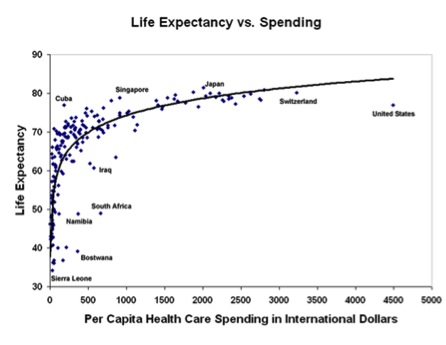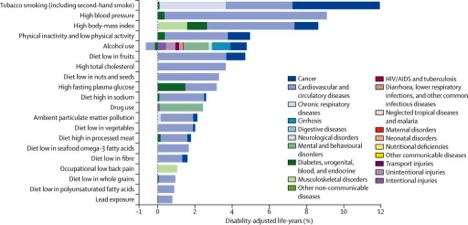Health vs. Health Care Spending
A few weeks ago I showed a couple of graphs on the relationships between income, happiness and life expectancy. The graphs demonstrated what can be described as a diminishing returns relationship with more and more resources required to generate even modest improvements in either happiness or life expectancy with an eventual flattening of the relationships. A similar trend exists for health care spending per person and life expectancy across the world.
Is the U.S. Underperforming?
A quick look at the graph above clearly suggests that the U.S. health care “system” is underperforming. But before anyone jumps to that conclusion it is important to ask what the health care system has to do with broad based measures of public health like life expectancy? The next graph is a summary by the King’s Fund in the UK from three studies that have addressed this topic. The point is that in two of the three studies traditional health care is a minor (15-25%) determinant of health. My personal take based on a lot thinking and reading on this topic is that the Mc Ginness 2002 breakdown (15%) is probably the most accurate of the three. In this context, most of the life expectancy problem in the U.S. is about health behaviors and social circumstance as opposed to the health care system. That having been said, there are plenty of ways to look at what is wrong with the U.S. health care system like uneven access to care, uncoordinated care, excess use of technology and high costs; but life expectancy per se is probably not a good metric.
Will a “Better” Health Care System Fix the Problem?
In the UK significant resources have been devoted to developing and improving access to health care and coordinating this care via the National Health Service (NHS). There has also been an effort to make sure that only evidence based treatments are used and that technology is appropriately deployed. While the fraction of the GDP spent on health care is much lower in the UK than in the US, costs have gone up dramatically in the past decade or two. Has this worked? The UK lags behind most of the EU15+ countries (the original 15 members of the EU, Australia, Canada, the USA, and Norway) in many indices of health in spite of the efforts of the NHS. The graph below shows that most of the problem is related to life style and things like smoking, drinking, diet and exercise. Again, things that are relatively independent of the health care system.
Life Expectancy and Women in the U.S.
In general life expectancy for women is a few years higher than for men. However, recent evidence suggests that life expectancy for less educated and poorer women is actually falling. This fall in life expectancy highlights the limits of health or medical care on public health and reinforces that it is all (or at least mostly) about choices, lifestyle and social circumstances.
Summary
The point of this post has been to try to dissociate some of the criticism of the U.S. health care system from these broad based markers of public health. There is plenty wrong with health care in the U.S., but the real problems for the population as a whole are driven by a combination of personal choices and social forces that dwarf both the many negatives associated with our fragmented health care system.
This entry was posted on Thursday, March 21st, 2013 at 5:32 am and is filed under Current Events, Health Policy. You can follow any responses to this entry through the RSS 2.0 feed. You can leave a response, or trackback from your own site.




